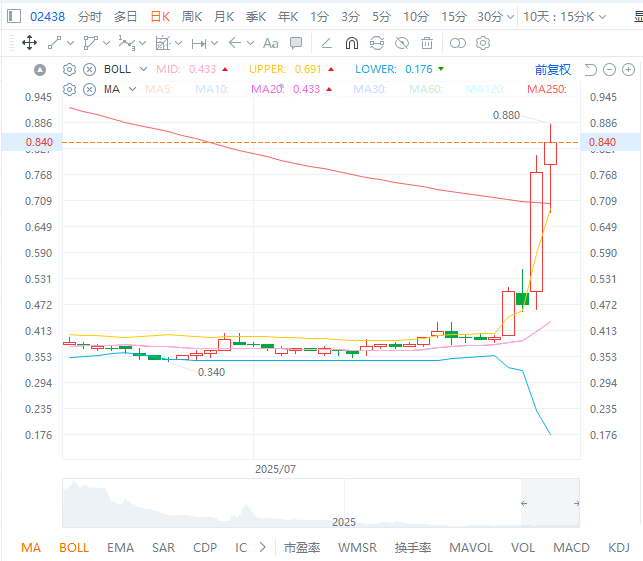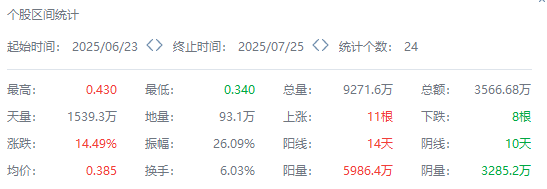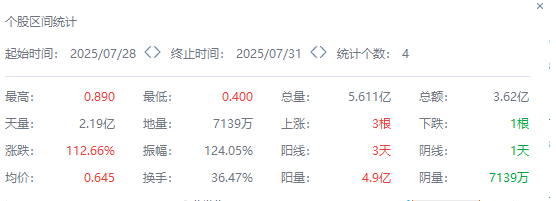Can a $13 billion market cap support a $20 billion business? Outgoing Questions (02438) triggers a valuation revolution
In recent four trading days, Outgoing Questions (02438) has skyrocketed over 112%, drawing attention from investors.

120% stunning surge before the night: The "蓄势" (stored energy) drama unfolds
In the evening of the day when Outgoing Questions created a 112% surge, a set of key data can reveal the hidden layout of funds' operations. From June 23 to July 25, the stock presented a typical "底部吸筹" (bottom-up accumulation) pattern. Under the calm surface with only a 14.49% gain, funds reconstructed the shareholding structure with precision, laying the foundation for subsequent mainline surges.
This period saw Outgoing Questions present an upward quantity-driven "慢牛式吸筹" (slow bull accumulation). Specifically, although the overall turnover rate was only 6.03%, the persistent differentiation of 5986.4 million shares vs 3285.2 million shares (ratio 1.82:1) exposed funds' "涨时抢筹、跌时控盘" (buy-high, sell-low) trajectory.
From a K-line angle, 14 consecutive green lines formed the "小步慢牛" (small-step slow bull) pattern, accurately controlling the gain within 14.49% (same-period amplitude only 26.09%), avoiding early attracting followers and preventing excessive accumulation. Meanwhile, 10 consecutive red lines continued to shrink (average quantity 328.5 million), particularly the final quantity of 93.1 million, signifying the depletion of floating shares. At this point, funds secured an average cost at HK$0.385, with only 14% space from the lowest price of HK$0.34, forming a solid bottom support and indicating a concentration of mainline accumulation at HK$0.34-0.38.

This stage can be described as a classic "蓄水池模型" (water reservoir model): through upward quantity injection, funds lifted the water level (holding cost), while downward quantity draining maintained the water level in control. When the 6.03% turnover rate and 93.1 million quantity resonated, it signified that market floating shares were almost exhausted, which is the energy source for the subsequent stock price surge.
The top five buy-side seats during this period were Fidelity International Hong Kong, Vantage Securities, Merrill Lynch Far East Limited, Chongbang Securities Hong Kong, and HSBC Holdings (Hong Kong), with shareholding ratios increasing by 0.327%, 0.2521%, 0.1439%, 0.1351%, and 0.0898%, respectively.

4-day flip: Behind the scenes, a massive shift in shareholding structure triggers a mainline surge
After the "蓄势" drama, Outgoing Questions opened up a 4-day flip. From July 28 to 31, the stock surged by 112.66%, with total turnover volume reaching HK$5.611 billion and total value amounting to HK$3.62 billion. Additionally, the upward quantity accounted for over 86% (49 million shares), while downward quantity only occupied about 14% (7.139 million shares), with buy-side pressure overwhelming.
This structural pattern of rising quantities and extremely low downward quantities is a typical signal for the onset of mainline surges.

From a "quantity" perspective, the stock achieved massive breakthroughs in terms of quantity and cost restructuring. On July 30, the daily turnover volume reached HK$2.19 billion (42% of the overall volume), breaking through the strong resistance level and triggering a short-covering response on the technical chart. In terms of "price," the stock's interval average price surged to HK$0.645, an increase of 65% from the previous platform (HK$0.385) and establishing a new mainline cost ceiling. Furthermore, the single-day turnover volume of 7.139 million shares was four times that of the pre-breakout day, indicating a significant enhancement in trading activity.
Worth noting is that the 36.47% turnover rate indicates that more than one-third of the circulating shares have changed hands, marking a milestone for new and old mainline forces to complete their handover.
The top five buy-side seats during this period were Citigroup Global Markets Limited, Tiger Securities Hong Kong, CITIC Securities Hong Kong, Riches Securities, and Prosperity Securities, with shareholding ratios increasing by 0.3166%, 0.2732%, 0.1854%, 0.1018%, and 0.0796%, respectively. The top five sell-side seats were HSBC Holdings (Hong Kong), Bank of China (Hong Kong), BNP Paribas Securities, Yaoxin Securities, and China International Capital Corporation (Hong Kong) Securities, with shareholding ratios decreasing by 0.7762%, 0.2179%, 0.0999%, 0.0758%, and 0.0650%, respectively.

Conclusion: The "三重奏" (three-piece suite) behind the surge - Fundamentals, restructuring, and valuation explosion
When technical charts' fundamental forces, strategic restructurings, and capital market's valuation explosions converge, Outgoing Questions' frenzied surge may have surpassed short-term speculation.
The "一重奏" (first piece) is about fund management: the stored energy drama unfolds.
The "二重奏" (second piece) is about business restructuring: from "三足虚浮" (three-legged stool) to "双核裂变" (dual-nucleus explosion). Outgoing Questions decisively cuts off its peripheral businesses, and AIGC takes the lead, with millions of users powering growth. Additionally, hardware cooperation activates ecological dividends.
The "三重奏" (third piece) is about valuation re-estimation: a $13 billion market cap's estimated value black hole.
